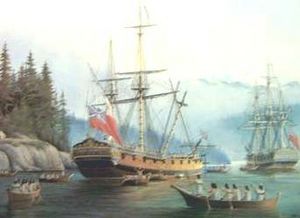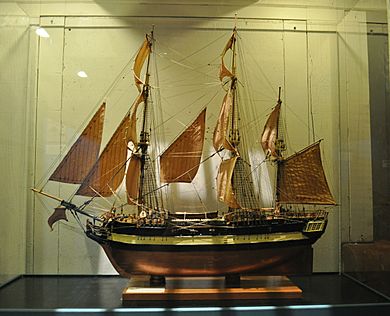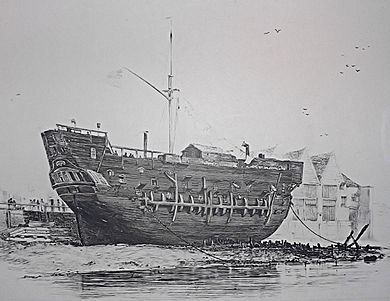HMS Discovery (1789) facts for kids
 |
|
Quick facts for kids History |
|
|---|---|
| Name | HMS Discovery |
| Builder | Randall, Gray & Brent, Rotherhithe |
| Launched | 1789 |
| Acquired | November 1789 |
| In service | 7 December 1789 |
| Reclassified |
|
| Honours and awards |
Copenhagen 1801 |
| Fate | Broken up by 15 February 1834 |
| General characteristics | |
| Class and type | 10-gun survey ship |
| Tons burthen | 33065⁄98 bm |
| Length |
|
| Beam | 28 ft 3+1⁄4 in (8.6 m) |
| Depth of hold | 12 ft 4 in (3.8 m) |
| Sail plan | Full-rigged ship |
| Complement |
|
| Armament |
|
HMS Discovery was a famous ship of the Royal Navy launched in 1789. She is best known for being the main ship in George Vancouver's amazing journey to explore the west coast of North America. This important trip, called the Vancouver Expedition, happened between 1791 and 1795.
After her exploration days, Discovery was changed into a bomb vessel in 1798 and took part in the Battle of Copenhagen. Later, she served as a hospital ship and then as a convict ship until 1831. The ship was eventually taken apart in 1834.
Contents
The Ship's Beginning

The ship Discovery was built in 1789 and bought by the Navy in 1790. She was named after an earlier ship, also called HMS Discovery. That first Discovery was one of the ships on Captain James Cook's third voyage to the Pacific Ocean. George Vancouver himself had served as a young officer on that earlier Discovery.
The Discovery was a full-rigged ship, meaning it had three or more masts with square sails. She usually had a crew of about 100 people. The ship was designed to explore the southern whale fishing areas.
Discoverys first captain was Henry Roberts, with Vancouver as his first officer. However, a political problem called the Nootka Crisis started in 1789. Because of this, Roberts and Vancouver were sent to other duties. The ship then became a storage ship for sailors brought in by press gangs at Chatham Dockyard. Later, Vancouver returned and was given full command of Discovery to help with the Nootka Convention, an agreement to settle the dispute.
Exploring New Worlds
Journey to the Southern Hemisphere
On April 1, 1791, Discovery left England with another ship, HMS Chatham. Both ships made a stop in Cape Town, South Africa. From there, they sailed to explore the southern coast of Australia.
While in King George Sound, the ship's naturalist and surgeon, Archibald Menzies, found many new plant types. One of these was Banksia grandis, which was the first time this type of plant was recorded in Western Australia. The two ships then sailed to Hawaii, where Vancouver met King Kamehameha I. After that, Chatham and Discovery continued their journey to the Northwest Pacific.
Mapping Northwest America
For the next four years, Vancouver used Discovery to map the northern Pacific Ocean coast. During the winters, they would stay in Spanish California or Hawaii. Vancouver named many places after his friends and colleagues. Some of these names are still used today:
- Mount Baker, named after Joseph Baker, who was the first on the trip to see it.
- Mount St. Helens, named after Lord St Helens.
- Puget Sound, named after Peter Puget, one of Discoverys lieutenants, who explored its southern parts.
- Mount Hood
- Mount Rainier
- Discovery Bay and Port Discovery.
Discovery's main goal was to show that Britain controlled this part of the Northwest Coast. This was especially important after the Spanish handed over their Fort San Miguel at Nootka Sound. However, working together with the Spanish was also a key aim. The exploration went very well, and relations with the Spanish were good. Getting supplies in California was especially helpful. Vancouver and the Spanish commander, Juan Francisco de la Bodega y Quadra, got along so well that Vancouver Island was first called Vancouver and Quadra's Island.

In 1793, Discovery sailed into a bay on the northern end of Prince of Wales Island. A storm came up, and the bay offered good shelter, so it was named Port Protection. Baker Point, the northwest tip of Prince of Wales Island, is named after Joseph Baker, who was the third lieutenant on the Discovery.
It is amazing that during Discoverys five-year journey, only six sailors were lost, and all of them died in accidents. No one died from scurvy (a disease caused by lack of Vitamin C) or from violence.
A Diplomatic Role
Discovery was also meant to help solve the question of who controlled Nootka Sound. Even after four years of sending messages back and forth with their home governments, Vancouver and Quadra could not officially agree on a solution.
Later Life of the Ship
In July 1795, Discovery arrived at St Helena. There, on July 2, 1795, Discovery and the smaller ship Chatham captured a Dutch trading ship called Makassar. The Dutch ship sailed in without knowing that the new Dutch government, the Batavian Republic, was at war with Great Britain.
From St Helena, Vancouver and Discovery sailed in a group with Sceptre, the trading ship General Goddard, their captured ships, and many other trading ships. They arrived in Ireland in September, and Discovery continued on to England.
After four years at sea, Discovery needed a lot of repairs. She was put away until 1798 when she was fixed up and changed into a bomb vessel. She was then put back into service under Commander John Dick.
In October 1800, Commander John Conn took over from Dick. Discovery took part in the Battle of Copenhagen in April 1801. Years later, in 1847, the Navy gave out a special medal, the Naval General Service medal, to all who had served in that battle.
On August 4, 1801, Discovery served with Nelson when he decided to attack enemy ships off Boulogne. On the night of August 15, the British attacked in four groups. Commander Conn was in charge of four boats armed with special cannons. Discovery had one man injured in this attack, which was not successful for the British. Discovery was then taken out of service in October and stored away in May 1802.
Final Years and Fate
Discovery was put back into service in May 1803 under Commander John Joyce. Commander Charles Pickford replaced him in August and stayed in command until 1805.
In 1807, Discovery was at Sheerness, serving as a hospital ship. She continued in this role, helping sick and injured sailors, until 1815.
In 1818, Discovery was changed into a convict ship at Woolwich. These ships were used to hold prisoners. In 1824, she moved to Deptford, where she continued to serve as a convict ship until at least 1831. The ship was finally taken apart there in 1834.
Famous People on Board
Many notable people served on Discovery during her great voyage of exploration:
- Captain George Vancouver
- 1st Lieutenant Zachary Mudge - who later became an admiral.
- 2nd Lieutenant Peter Puget - who also became a rear admiral.
- 3rd Lieutenant Joseph Baker - who became a captain.
- Master Joseph Whidbey - later known as a naval engineer.
- Thomas Manby - started as a master's mate and was promoted to lieutenant on Discovery.
- William Robert Broughton - first commanded the Chatham, and later became a rear-admiral.
- Archibald Menzies - the ship's naturalist and surgeon, who discovered new plants.
- Thomas Pitt, 2nd Baron Camelford - a young officer who was sent back to England because of bad behavior.
- Robert Barrie - later a commissioner at a dockyard in Canada.
See also
- European and American voyages of scientific exploration


